The CSS Solved General Science & Ability (GSA) Past Paper 2023 is Solved by Pakistan’s top GSA Coaches, Miss Iqra Ali and Sir Ammar Hashmi. They are the only coaches available in Pakistan who have solved the last 20 years GSA solved papers to help aspirants know how to attempt the paper to score above 80. And they have guided thousands of CSS and PMS aspirants. Both coaches have been known for their teaching methodology and imparting concepts to their students, who scored the highest marks in this subject. At the special request of CSSPrepForum, both coaches have solved the paper.

SECTION-I
Question No. 2
(A) Define ceramic and nano-ceramic materials. Why the nano-ceramics show better properties than their ceramic counterparts? Write the applications of ceramic materials?
Question Breakdown
The question is split into three parts. Thus, you need to answer it accordingly by giving equal weightage to all. First, define the terms “Ceramic” and “Nano-Ceramic” in your words with suitable examples. Next, give the examiner the reason for what makes nano-ceramics better than their ceramic counterparts. In this part, you have to give the structural differences of both. In the last step, sum up the answer with four to five applications of ceramics in bullet form, keeping in mind that the weightage of this part does not exceed that of the first two. Remember, stick to what examiner has actually asked. Do not stretch your question with unnecessary information if not required. No diagram is needed for this question.
Answer
Define Ceramic
The term ‘Ceramic’ is a Greek word meaning ‘pottery’. However, pottery is just one part of the ceramic world. In fact, ceramic is an inorganic non-metallic solid that is hard, brittle and resistant to corrosion and heat. They are made by shaping clay or other earthen minerals and hardened by heating them to high temperatures.
For Example
- Tiles
- Cement
- Porcelain
- Plates
- Watches (quartz tuning forks-the timekeeping devices in watches)
- Toilets, etc.
Define Nano-ceramic
Nano-ceramics are ultrafine particles composed of ceramics with particle size less than 100 nm. These were first discovered in the early 1980s and are primarily made up of highly pure well-chosen oxides, carbides, carbonates, and phosphates of metals and metalloids, such as calcium, titanium, silicon, etc. The synthesis involves successive heating and cooling processes through a well-known procedure called sol-gel under high pressure and temperature to achieve the required size. Physically, they are harder and more rigid than macro-ceramics and have comparatively high heat resistance.
For Example
- Silica (SiO2)
- Titania (TiO2)
- Alumina (Al2O3)
- Iron Oxide (Fe3O4, Fe2O3)
- Zinc Oxide (ZnO) etc.
Why the nano-ceramics show better properties than their ceramic counterparts?
In the modern era, nano-ceramics play an important role in society and show better properties like low cost, improved mechanical properties, thermal stability and fire resistance, strength like steel, and substantial resistance against compression and bending than their ceramic counterparts due to exceptionally grounded small particles size that gives them a non-porous structure and a high surface area. Further, the properties of nano-ceramic vary significantly from one size to another, which can be measured by surface characterization methods such as X-ray Diffraction Analysis, Infrared Spectroscopy, Scanning Electron Microscopy, Transmission Electron Microscopy, Atomic Force Microscopy, etc.
The applications of ceramic materials.
Ceramic materials display a wide range of applications.
- Aerospace:
Ceramics are used in space shuttle tiles, high-temperature glass windows, thermal barriers, fuel cells, etc. - Consumer Uses:
They are used in glassware, pottery, windows, magnets, ceramic tiles, home electronics, lenses, etc. - Automotive:
In the automotive industry, ceramics are used in catalytic converters, ceramic filters, enamel coating, spark plugs, pressure sensors, thermistors, nose cones of aeroplanes, etc. - Medical (Bio-ceramics):
Ceramic particles can be used for bone repair, drug delivery, orthopaedic joint replacement, dental restoration, etc. - Military:
Ceramics can also be used as structural components for ground, air, and naval vehicles, sensors, missiles, etc.
(B) What is ‘Black Hole’? How black holes are formed and discovered?
Question Breakdown
In this question, the examiner has asked you to address two things. First, simply elucidate the term ‘black hole’ in your own words and give its example. In the next part of the question, there are again two portions: the discovery of a black hole and its formation. Hence, at first, give a brief overview of how the first black hole was discovered, and, in the end, write the process of its formation in detail with a simplified diagram.
Answer
What is Black Hole?
A black hole is a cosmic body in the centre of almost every galaxy in the universe, including the Milky Way galaxy, in which our solar system exists. The gravity and density inside the black hole are so strong that it attracts everything coming towards it; even electromagnetic radiation cannot escape. Hence, a black hole cannot be observed directly. However, it can be observed by its gravitational influence on nearby matter. The boundary of black holes is called the ‘event horizon’.
For Example
Sagittarius A* is a supermassive black hole that exists at the centre of the Milky Way Galaxy.
How black holes are formed and discovered?
- Discovery of Black Hole
Although the existence of black holes was first predicted by Albert Einstein in 1916 in his general theory of relativity, the first official black hole was discovered in 1964 by astronomers when a sounding rocket detected celestial sources of X-rays. The first black hole detected, according to NASA, was Cygnus X-1, located within the Milky Way in the constellation of Cygnus, the Swan. However, the term “black hole” was not coined until 1967, when American astronomer John Wheeler named it so. Moreover, in 1971, astronomers determined the X-rays were coming from a bright blue star orbiting a strange dark object – an all-consuming black hole.
- Formation of Black Hole
A black hole is formed by the death or explosion of extremely massive stars with sizes of more than three solar masses. At the end of a massive star’s life, the core of the star becomes highly unstable and collapses. The crushing weight of its constituent matter falling in from all sides compresses the dying star to the point of zero volume and infinite density called the singularity.
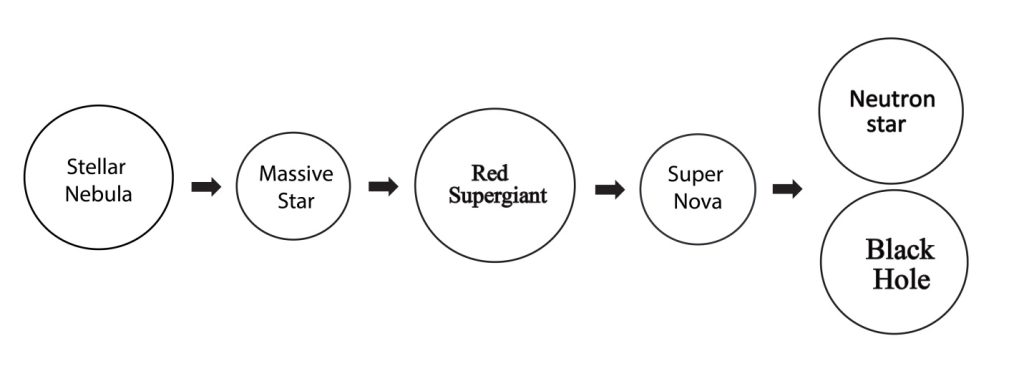
(C) Write two applications of each of the following electromagnetic radiations:
1) Ultraviolet
2) Infra-red
3) Microwaves
4) Radio waves
5) X-rays
Question Breakdown
In this question, the examiner has simply asked you to write down two applications of the given electromagnetic radiation. Thus, all you have to do is just write two applications each of ultraviolet, infrared, microwaves, radio waves, and x-rays. Although defining electromagnetic radiations and making diagrams are not required in this question, you can define or draw a minimal flow chart relevant to the answer. Remember, writing extra content is not what assures you good marks, but it is the presentation that makes your answer paper stand out among thousands.
Answer
Electromagnetic Radiations
Electromagnetic radiations are transverse waves in which the electric and magnetic fields are perpendicular to each other and to the direction of propagation of the wave.
Depending on the frequency of oscillation, different wavelengths of the electromagnetic spectrum, from gamma rays to radio waves, are produced.
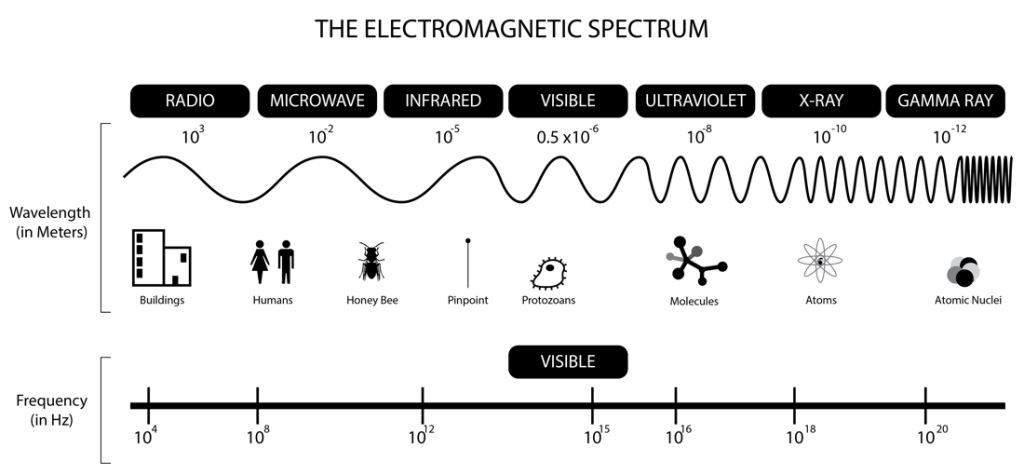
Application of Different Electromagnetic Waves:
- Ultraviolet Radiations
- Ultraviolet radiations are used in energy-efficient lights, in which fluorescent substances absorb UV light produced inside the lamp and re-emit the energy as visible light.
- UV radiations are also used on bank notes to detect forgeries and allow investigators and forensic researchers to examine clues and recover evidence by providing more detail and contrast to the suspected area than standard lighting techniques.
- Infrared
- In medicine, infrared radiations can promote local blood circulation through their heating effect and reduce muscle tension, thus, being used in the treatment of autoimmune diseases or wound-healing disorders.
- In homes, infrared radiation is used by electrical heaters, cookers for cooking food, short-range communications like remote controls, optical fibres, security systems, and thermal imaging security cameras that detect people in the dark.
- Microwaves
- One of the major applications of microwaves in homes is in the kitchen, i.e. the microwave oven. The magnetron present in the internal circuitry of the microwave oven emits microwaves. These emitted radiations get reflected on striking a metallic surface and get absorbed by the food particles. This property of microwaves is utilized to heat and cook food.
- The operation and working of global positioning systems (GPS), Wi-Fi, and Bluetooth are based on microwaves. Moreover, these are used in various communication techniques, such as satellite communication, cellular communication, optical communication, point-to-point communication, wireless communication, etc.
- Radio waves
- Radio waves, with their longest wavelengths, are used to transmit data from radios, televisions, satellites, and RADAR.
- Cellular mobile phones use radio waves to transmit voice communication.
- X-rays
- In medicine, X-rays are used in the diagnosis of fractures of bones, foreign bodies like bullets and stones in the body, and dental pathologies. Moreover, these are also used in the treatment of certain types of cancer.
- In industry, X-rays are used to test the homogeneity of welded joints and to detect the structural defects of inaccessible parts of machinery.
(D) What is Wildfire? Explain its types, causes, spread and preventions.
Question Breakdown
In this question, the examiner has asked you to explain multiple things:-understanding about a wildfire, its types, causes, spread, and preventive measures. Thus, to answer such questions, try to split your weightage and address every part justly. Don’t skip even a single part. Moreover, the question doesn’t demand extraordinary explanations. Just write three to five lines in each heading. You can draw diagrams to make the answer more presentable.
Answer
What is wildfire?
Wildfire is an unplanned, uncontrolled fire that burns in a natural area of combustible vegetation, such as grasslands, forests, or prairies and wipes out large areas of land and fields.
For Example
The 2021 fires in the pine forests of the Koh-E-Sulaiman range and Margalla National Park in Pakistan have destroyed 189 acres and 45 acres of land, respectively.
Types of Wildfire
There are three types of wildfire
- Ground fires
Ground fires burn mostly in decayed roots below the ground and in the duff layer. The duff layer is made up of compacted, dead plant materials such as leaves, bark, needles, and twigs. Ground fires are sustained by glowing combustion (without flames) and can go undetected for a long time because they produce little to no smoke and spread slowly.
- Surface fires
Surface fire occurs within the lower level of the forest and burns loose needles, herbaceous vegetation, lichens, shrubs, moss, small trees, and saplings that are at or near the surface of the ground. Surface fires are common; however, their intensity is usually low
- Crown fires
Crown fire is a fast-moving fire involving burning in the upper canopy of vegetation, which includes live and dead foliage/branches, lichens in trees, and tall shrubs that lie well above the surface fuels. These fires of vegetation both at the surface and crown fuel layer farther up the tree. Since the influence of wind is greater in the canopy, and the canopy is composed of interconnected vegetation, these fires can spread quickly.
Causes of Wildfire
Wildfires can be caused by natural events or human activities.
- Natural Causes of Wildfire
Natural causes of wildfires include- Lightening
- Heat waves
- Volcanic Lava
- Anthropogenic Causes of Wildfire
- Unextinguished Cigarettes
- Industrial activity
- Fireworks, sky-lanterns, outdoor flame lighting
- Arson
Spread of wildfire
According to the National Interagency Coordination Center (NICC) Wildland Fire Annual Report for 2022, “68,988 wildfires were reported in 2022 that have consumed 7,577,183 acres, compared to 58,985 wildfires in 2021 having consumed 7,125,643 acres.
Wildfires’ spread in intensity to scorch the forest canopy depends on multiple factors
- The amount of fuel
- Fuel moisture content
- Wind speed
- The height from the base of tree crowns
- The density and compactness of tree crowns

Ways to prevent wildfire
- Campfire or bonfire must only be arranged in an appropriate fire pit, cleared of all vegetation and ringed by stones.
- Used matches and butts while smoking must be discarded in a closed container or cup of water.
- Yard waste or rubbish must be burned in a 50-gallon drum or fire pit, and that too only when allowed by the relevant municipality
- Any hot car or another machine must not be parked in dry grass.
- Burning fire, if necessary to be kept burning, must never be left unattended.

Question No. 3
(A)
1) Why the bat and whale are considered as mammals?
2) Write a note on liver juice ‘Bile’?
Question Breakdown
The question consists of two parts. In the first part, the examiner has asked you to give the reason why bats and whales are considered mammals. To answer this, you’ll have to describe the characteristics of mammals after defining them in relation to bats and whales. Likewise, in the second part, you are supposed to write a note on Bile with an appropriate diagram. Remember writing too much cannot help you secure good marks. All that can help is your presentation and proper breakdown of questions.
Answer:
1-)
Bats and whales are classified as mammals because they have various characteristics that define mammals as a group. These characteristics include
- Both bats and Whales have Four Chambered hearts.
- Females of both possess mammary glands that are they are capable of producing milk to nourish offspring.
- Both are, like all other mammals, warm-blooded animals, creating enough internal heat to maintain a temperature higher than that of their environment.
- They have advanced respiratory structures possessing well-defined lungs, which allow them to extract oxygen from the air and release carbon dioxide.
2-)
Define Bile as “Liver Juice”
Bile is a yellowish-greenish digestive fluid produced by the liver and stored in the gallbladder.
Composition of Bile:
Bile is a waste product composed of water, minerals, cholesterol, neutral fats, phospholipids, bilirubin and other pigments, bile acids, and lipid-transport vesicles.
Role of Bile:
Bile aids in fat digestion and absorption. Whenever a fat-rich food is consumed, the gallbladder releases bile into the small intestine through the bile ducts, which then helps in the breakdown of fats into smaller droplets, increasing their surface area and allowing enzymes called lipases to efficiently break down the fats into fatty acids and glycerol. Moreover, bile also helps in the elimination of waste products, such as bilirubin – a byproduct of red blood cell breakdown.
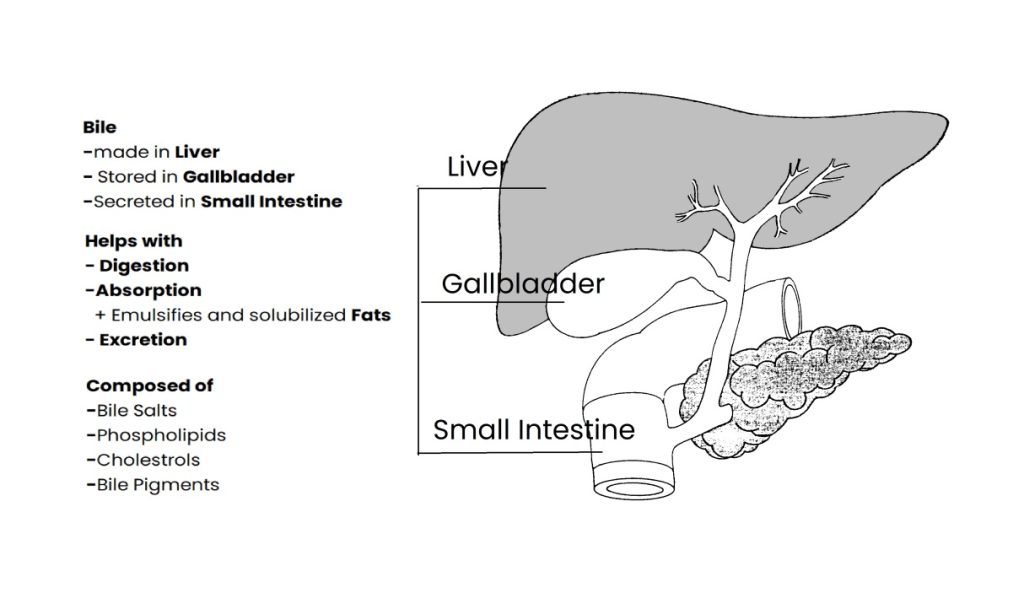
(B) How the urine is formed? Describe the role of kidney in excretion?
Question Breakdown:
In the first part of the question, the examiner has asked you to explain the production of urine with all the structures involved along with their functions. Making the diagram along with the procedure is what will award you maximum marks in the competitive exam. However, avoid writing irrelevant things which are not connected to the question directly.
Answer:
Urine- a liquid by-product of metabolism in humans and in many other animals- is formed through a process called urine formation or renal filtration in the kidneys, which is then eliminated through the body through a process called excretion via ureters, urinary bladder, and urethra respectively.
- An overview of the structures involved in urine formation:
The main structures in the whole excretory system that is responsible for urine formation are the nephrons which are around one million in number in each kidney. Nephron is a basic structural and functional unit of the kidney that is further composed of
- Bowman’s Capsule – A cup-shaped Swelling at the inner end of the nephron
- Glomerulus- Ball of Capillaries inside bowman’s capsule
- Afferent arterioles- Arterioles that enter the glomerulus
- Efferent arterioles- Arterioles that leave the glomerulus
- Proximal convoluted tubules- between bowman’s capsule and descending limb
- Descending limb of the loop of Henle
- Ascending limb of the loop of Henle
- Distal convoluted tubules- between ascending limb and collecting duct
- Collecting Duct- enters into ureters
With structures moving from the cortex towards the medulla, respectively
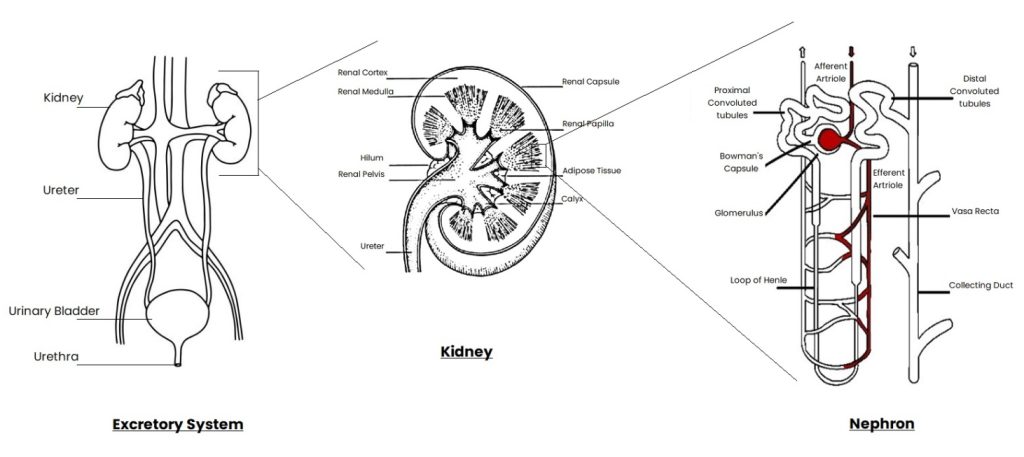
- The Process of Urine Formation and the Role of Kidney
The function of kidneys and blood in clearing wastes is very evident from the fact that the weight of kidneys accounts for less than 1% of the total body weight while receiving 20% of blood supplied with each cardiac beat. Following filtration of blood and further processing through the tubular system, urine is collected in a central cavity of the kidney, pelvis.
The mechanism of urine formation involves the following three steps mainly.
- Glomerular Filtration
Glomerular filtration occurs in the glomerulus, where blood is filtered. This process occurs specifically here because, unlike other parts of the vessel, the glomerulus walls are porous, and the filtration of blood pressure reaching here provides the filtration pressure. The filtration appearing in Bowman’s capsule is called glomerular filtrate, which contains numerous useful substances, such as glucose, amino acids, salts etc., in an aqueous solution. - Selective Reabsorption
Around 99 per cent of the filtrate obtained is reabsorbed in proximal tubules, and when filtrate leaves proximal tubules, it mostly contains nitrogenous wastes. This is known as reabsorption, which is achieved by active and passive transport. - Secretion
The next step in urine formation is tubular secretion. The tubular epithelium also secretes substances into the lumen; this secretion is very selective and is mainly of hydrogen ions to balance the pH value of the filtrate passing through the tubule. The secreted ions combine with the filtrate and form urine. The urine passes out of the nephron tubule into a collecting duct.
The urine produced is 95% water and 5% nitrogenous waste. Wastes such as urea, ammonia, and creatinine are excreted in the urine. Apart from these, the potassium, sodium and calcium ions are also excreted.
(C)
1) How a bacterial cell is different from a plant cell
2) What do you think cold-blooded animals are slowed down by low temperatures?
Question Breakdown
The question mainly consists of two parts. In the first part, the examiner asked you to explain the difference between bacterial cells and plant cells. Thus, simply write the contrast points of both in tabular form, including diagrams. Coming to the next part, you are required to explain the reason why cold-blooded animals are slowed down by low temperatures. Thus, simply give the justification of the statement with valid arguments after defining the cold-blooded animals with examples. Remember writing too much will not help you ace maximum marks in General Science and Ability paper.
Answer
1-)
| Characteristics | Bacterial Cell | Plant Cell |
| Definition | A bacterial cell is a body of a single-celled, prokaryotic organism. | A plant cell is the structural and functional unit of a plant. |
| Form and Type | Unicellular Prokaryote | Multicellular Eukaryote |
| Cell wall | The bacterial cell wall is made of Murine. | The plant cell wall is made of cellulose. |
| Cytoskeleton | Bacterial cells do not contain any cytoskeleton. | Plant cells consist of a cytoskeleton, which is made up of microtubules and microfilaments. |
| Cell Division | The bacterial cell division occurs by binary fission. | The plant cell division occurs by mitosis or meiosis. |
| Sexual Reproduction | Sexual reproduction of the bacterial cells occurs by conjugation. | Sexual reproduction occurs by the fusion of gametes in plant cells. |
| Membrane Bounded Organelles | Bacterial cell lacks membrane-bound organelles. | The bacterial cell consists of membrane-bound organelles. |
| Types | There are two types of bacterial cells Gram-positive bacteria and Gram-negative bacteria. | There are three types of plant cells ParenchymaCollenchymaSclerenchyma. |

2-)
Definition of Cold-Blooded Animals:
Animals that are not capable of generating internal heat are called cold-blooded animals or poikilotherms, or ectothermic animals.
For Example:
- Insects
- Worms
- Reptiles
- Fish
- Amphibians
Are cold-blooded animals slowed down by low temperatures?
Yes, cold-blooded animals are often slowed down by low temperatures because, unlike warm-blooded animals whose heat is regulated internally, the surrounding environment determines the body temperatures of ectotherms. As a result, when the temperature falls down, the metabolic processes and overall metabolic rate and, thus, physiological functions of cold-blooded animals tend to drop. Moreover, their muscle contractions become slower, making their movements sluggish and less efficient. This is why many reptiles and amphibians become less active or even enter a state of hibernation during colder periods, while others may seek out warmer areas or bask in the sun to raise their body temperature and increase their activity levels.
(D) What is hepatitis, its types, causes, prevention, and cure?
Question Breakdown
In this question, the examiner has asked you to explain hepatitis, its types, causes, prevention, and cure. So, write down all the required details briefly to score maximum marks. However, you can either draw a table or write in points or paragraphs with appropriate headings, the way you think you can make it more presentable. Remember, writing too much will never help you score maximum marks on your GSA paper, but the relevant and required material with a decent presentation.
Answer:
Hepatitis:
Hepata: Liver
Itis: Inflammation
Hepatitis refers to an inflammatory condition of the liver. Primarily, it is a viral disease, but there are other possible causes of hepatitis. These include autoimmune hepatitis- a disease that occurs when a human body makes antibodies against liver tissues- and hepatitis, which occurs as a secondary result of medications, drugs, toxins and alcohol.
Types, Causes, Prevention, and Cure of Hepatitis
| TYPES | CAUSES | PREVENTION | CURE |
| Hepatitis A | HAV Picornaviridae- a non-enveloped RNA virus transmitted through ingestion of contaminated food and water or through direct contact with an infected person. | Vaccines for hepatitis A are available. Moreover, safe water supply, food safety, improved sanitation, and regular washing of hands are the most effective ways to combat the disease. | It may not require treatment. However, if symptoms cause a great deal of discomfort, bed rest may be necessary. |
| Hepatitis B | HBV Hepadnavirida- a DNA virus transmitted to a person through contact with the blood or other body fluid of an infected person. | It can be prevented by currently available vaccines. Moreover, avoiding used syringes, safe sex practices, and implementing blood safety strategies can help in the prevention of Hepatitis B. | Acute hepatitis B generally resolves on its own. However, chronic HBV is treated with multiple Immune modulator drugs or oral antiviral medications, but they may not be appropriate for everyone. |
| Hepatitis C | HCV Flaviviridae- an RNA-enveloped virus transmitted through unsafe injection practice, inadequate sterilization of medical equipment, unsafe sex, and from an infected mother to her baby | Currently, there is no vaccine available for hepatitis C. However, implementing blood safety strategies, safe sex practices, and proper disposal of used syringes can be effective strategies to protect against transmission. | Antiviral medicines can cure more than 95 per cent of persons with hepatitis C infection, but access to diagnosis and treatment is low. |
| Hepatitis D | HDV Deltaviridae- a defective RNA virus which requires the help of hepatitis B virus (HBV) virus for its replication; transmitted, like HBV, occurs through broken skin or through contact with infected blood or blood products. | Vaccination against hepatitis B is the only method to prevent HDV infection. Moreover, avoiding used syringes, safe sex practices, and implementing blood safety strategies can help in the prevention of Hepatitis D too. | There’s no cure yet for HDV. However, doctors generally prescribe pegylated interferon alfa, that too may take around one year for recovery and can have multiple side effects. |
| Hepatitis E | HEV Caliciviridae- a non-enveloped single-stranded RNA virus | Hepatitis E is now, fortunately, a vaccine-preventable disease. However, Prevention relies primarily on good sanitation and the availability of clean drinking water. | There is no specific treatment for acute hepatitis E as the disease is usually self-limiting, Most important is the avoidance of unnecessary medications. |
Question No. 4
(A) What is the difference between fog and smog? What are the causes of smog and its effects on human health? Write a short note on any one of the latest technology to eliminate smog to avoid atmospheric pollution.
Question Breakdown
Critically, the examiner has asked you to explain four main things in the answer. In the first part, the examiner has asked you to explain the difference between fog and smog comprehensively. Thus, start with the difference in tabular form. Then write the causes and effects of smog in bullet form to give it a complete yet comprehensive overview of smog. After that, explain any of the latest technology working to eliminate smog from the atmosphere. Keep in mind not to write too much in your GSA paper since the question contains no more than five marks; thus, write accordingly.
Answer
| Characteristics | Fog | Smog |
| Definition | A weather phenomenon where water droplets are suspended in the air, reducing visibility at ground level | A type of air pollution resulting from a mixture of smoke and fog, often found in urban areas. |
| Composition | Consists of tiny water droplets suspended in the air | Consists of a combination of smoke, pollutants, and fog |
| Formation | Primarily naturally occurring and occurs when warm, moist air cools rapidly near the ground. | Primarily an artificial phenomenon resulting from human activities, particularly industrial emissions formed by the interaction of pollutants with sunlight |
| Location | It can occur in various locations, including coastal areas, valleys, and forests. | Typically found in densely populated urban areas with high levels of pollution. |
| Effects | Impacts transportation and aviation and causes delays | It can have detrimental effects on human health, causing respiratory issues and eye irritation |
| Solutions | No direct solutions, but they can be mitigated by reducing activities that contribute to pollution. | Requires controlling and reducing emissions from industrial sources, improving vehicle emissions standards, and implementing air pollution control measures |
Causes of Smog:
- Overpopulation is a significant cause of smog. More usage of agricultural products, industries, and transport increases pollution.
- Fireworks also increase the level of air pollutants in the atmosphere. On Diwali, the big cities have a high level of smog.
- The use of coal as a fuel has become a prominent contributor to the smog.
Effects of Smog:
- The pollutants present in the smog enter the human body through inhalation. It causes bronchitis, lung cancer, and other respiratory disorder.
- The pollutants in the smog also cause skin cancer, skin rashes, and redness of the skin can occur.
- Road accidents increase because the visibility sometimes decreases by 1km.
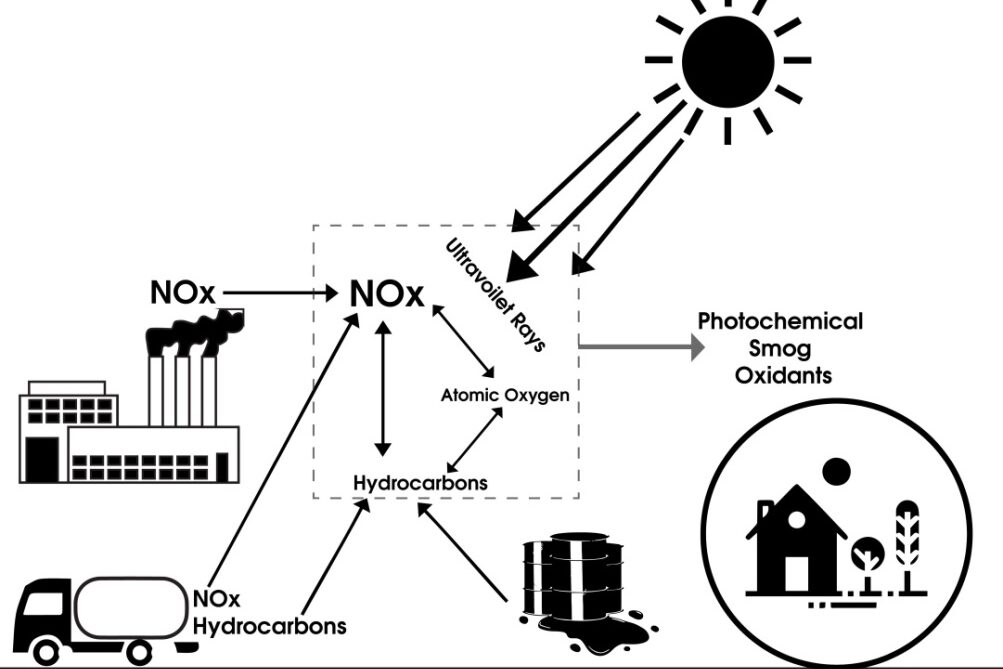
The latest technology to eliminate smog to avoid atmospheric pollution
- Incinerators (a waste treatment process that involves the use of a furnace for the combustion of substances contained in waste materials)
- Gravitational settling chambers (the oldest and simplest devices that collect solid particulates from gas streams)
- Electrostatic precipitators (removes particles from a gas stream by using electrical energy to charge particles either positively or negatively)
- Fabric filters
- Biofilters
(B) What is the role of oxygen-demanding wastes in water pollution? How it can be prevented?
Question Breakdown
In the first part of the question, the examiner has asked you to explain the role of oxygen-demanding wastes in water pollution. However, instead of directly moving to the role, starts your question with an appropriate definition of ODWs with examples. Then in the next part, explain the ways to prevent ODWs to limit water pollution in bullet form so that the length of the question may not extend much, Keep in mind not to write too much in your GSA paper since the question contains no more than five marks; thus, write accordingly.
Answer
Definition of oxygen-demanding wastes
Oxygen demanding wastes-also known as organic wastes- are water wastes that are decomposed by oxygen-requiring bacteria. These organic wastes can be solids, liquids, or gases coming from the sources like sewage, animal manure, and agricultural runoff, either directly or through leaching.
The role of oxygen demanding wastes in water pollution
Organic wastes have a significant impact on water quality. When these materials decompose in water, they consume oxygen, which can lead to the formation of hypoxic-low oxygen- or anoxic-no-oxygen- conditions. As a result, the biological oxygen demand (BOD) to decompose the wastes increases, and the Dissolved Oxygen (DO) level of water reduces drastically. This can be harmful to aquatic organisms and can lead to the release of harmful compounds such as ammonia and hydrogen sulfide. In the long-term, oxygen-demanding wastes can contribute to eutrophication or the over-enrichment of water bodies with nutrients, which can lead to algal blooms and other water quality issues.
Ways to prevent oxygen-demanding wastes from water bodies:
There are a number of ways to prevent oxygen-demanding wastes from polluting water:
- Municipal and industrial wastewater should be treated to remove oxygen-demanding wastes before it is discharged into waterways.
- Agricultural runoff can be managed by using conservation practices, such as cover crops and buffer strips. These practices can help to keep pollutants from washing into waterways.
- Businesses should use more sustainable practices, such as composting food waste, instead of sending it to a landfill.
- Sewage treatment plants should use aeration to add oxygen to the water, which helps to break down oxygen-demanding wastes more quickly.
- Industries should use on-site wastewater treatment systems to reduce the amount of waste that is discharged into waterways.
- Individuals must also reduce their own contribution to oxygen-demanding wastes by composting food waste, using less fertilizer, and disposing of household hazardous waste properly.
(C) What is the biosphere? Write a note on the “Energy Resources” available in the biosphere.
Question breakdown
In this question again, the examiner has asked two main questions. Firstly, you are required to explain the definition of biosphere. Thus, answer it with a proper diagram. Remember, when the examiner has not demanded the definition of jargon in the question, you can define it in a line or a phrase to give initiation to your answer; however, when the examiner himself asks you to define, define the term as comprehensively as possible with all required examples and diagrams. After it, explain the energy resources present in the biosphere. Again, drawing the key along with writing theory is the best possible approach, Remember, being creative is the key to attaining a good score in the General Science and Ability paper.
Answer
Definition of Biosphere:
In the simplest terms, Biosphere is the part of Earth that supports life. It also involves the abiotic factors that provide living organisms with nutrients and energy, including sunlight, water, soil, and the environment. The biosphere is considered to be formed by the interaction of the atmosphere, lithosphere and hydrosphere.
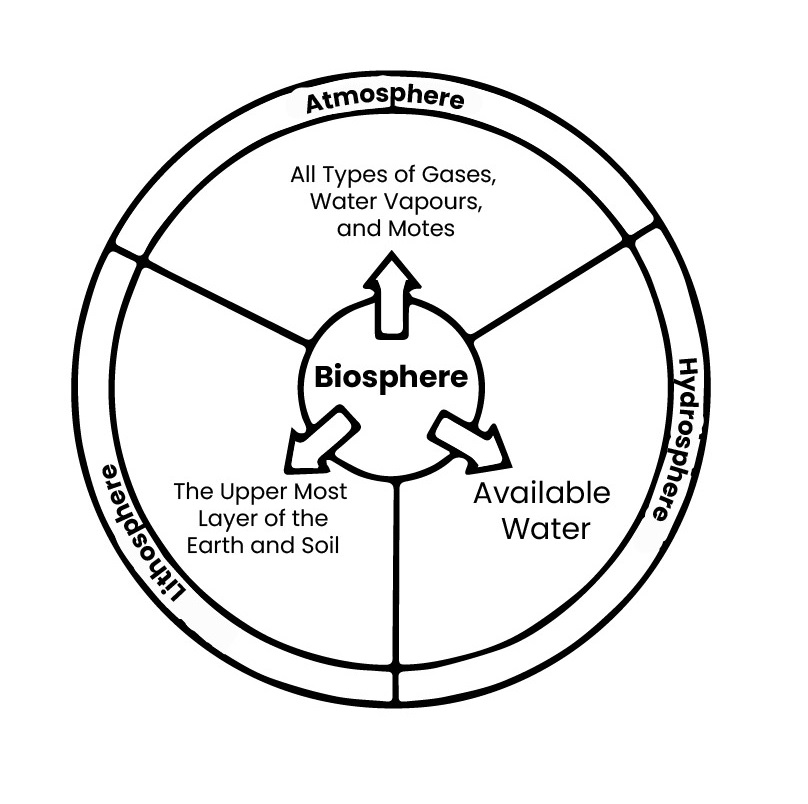
The “Energy Resources” available in the biosphere
The energy resources in the biosphere can be divided into two main types: Renewable Energy Resources and Non-Renewable Energy Resources.

- Renewable Energy Resources:
The sources of energy which on usage can’t be lost forever, but can be recycled and replenished. These include- Wind Energy:
Wind power is a renewable energy resource generated by harnessing the kinetic energy of moving air to run turbines for the generation of electricity, providing a sustainable source of power. - Solar Energy:
Sunlight- being a crucial renewable energy resource in the biosphere- is utilized through solar panels for electricity generation. - Hydropower:
Hydropower utilizes the energy of flowing water to generate electricity. It involves the use of dams or water turbines to convert the potential energy of water into mechanical and electrical energy. - Biomass:
Biomass- the organic matter derived from plants, animals, and microorganisms-serves as a renewable energy resource through processes such as combustion, fermentation, or anaerobic digestion to produce heat, electricity, or biofuels like biodiesel and bioethanol.
- Wind Energy:
- Non-Renewable Energy Resources:
The sources of energy which, on usage lost forever and can’t be recycled and replenished are called non-renewable energy resources. They are- Fossil Fuels:
Fossil fuels, including coal, oil, and natural gas, are formed from the remains of ancient plants and animals. They are non-renewable energy resources that release energy when combusted, which is then used for electricity generation, transportation, and heating. - Geothermal Energy:
Geothermal energy is derived from the heat within the Earth’s crust. It involves extracting heat from hot water or steam reservoirs underground to generate electricity or provide heating and cooling systems. - Nuclear Energy:
Nuclear energy is obtained through the process of nuclear fission, where the nucleus of an atom is split, releasing a significant amount of energy.
- Fossil Fuels:
(D) What are the different layers of the atmosphere? On what basis these layers are classified? In which layer “Auroras” are formed, and where do satellites orbit?
Question Breakdown
This question has mainly two parts. In the first part, the examiner has asked you to describe the layers of the atmosphere in a brief manner. First, start your answer by defining the atmosphere. When done, write down the names of layers along with their explanation briefly. Also, draw a diagram to score maximum marks. When done, move towards the next segment in which the examiner has asked you to mention the basis on which the layers are classified. The answer cannot comprise more than a line, so be to the point. Lastly, Explain the layer in which auroras are formed with appropriate justification.
Answer:
What is Atmosphere?
The layers of gases around the earth are called Atmosphere. In other words, an atmosphere contains the air that we breathe and is a blanket of gases that surrounds Earth. Moreover, it is held near the surface of the planet by Earth’s gravitational attraction.
Layers of Atmosphere
The atmosphere can be categorized in 6 layers
- Troposphere:
The bottom-most layer of the atmosphere where we live is the troposphere. It extends upward to about 10km above the sea level, starting from the ground level. It comprises 75% of all air in the atmosphere; its lowest part is known as the boundary layer, while the topmost layer is called the tropopause. - Stratosphere:
Above the troposphere lies the stratosphere. Its distance from the surface of the earth is 12 -50 Km. The ozone layer lies in the stratosphere; the stratosphere is the layer where aeroplanes fly. - Mesosphere:
The layer of ions is Mesosphere. It extends to a height of about 85km from the ground level. - Thermosphere:
The topmost layer of strata of the atmosphere is the thermosphere. Its distance from the earth’s surface is 80-320 Km. Satellites orbit Earth within the thermosphere. - Exosphere:
The pseudo or false atmosphere above 500 km is the exosphere. It is the final frontier of the Earth’s gaseous envelope. The exosphere is 10,000 km from the earth’s surface. However, there’s no clear-cut upper boundary where it finally fades away into space. - Ionosphere:
The ionosphere is an abundant layer of electrons and ionized atoms and molecules that stretches from about 48 kilometres (30 miles) above the surface to the edge of space at about 965 km (600 mi), overlapping into the mesosphere and thermosphere. This region is what makes radio communications possible.
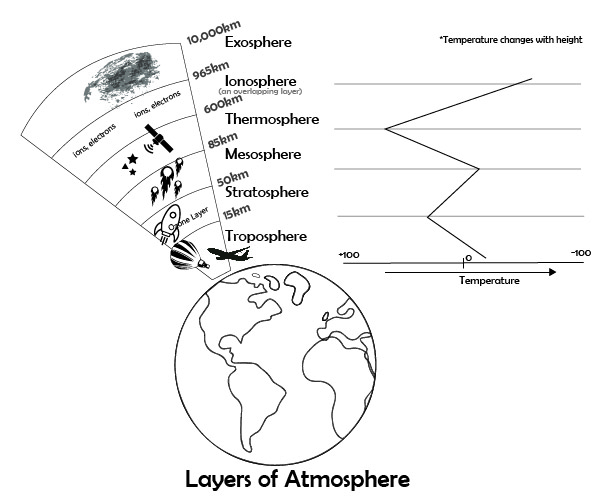
On what basis the layers are classified?
The layers of the atmosphere are classified on the basis of their temperature.
In which layer of atmosphere auroras are formed?
Auroras are formed in the thermosphere, the uppermost layer of the Earth’s atmosphere. Within the thermosphere, auroras occur in the region known as the auroral zone, typically between 100 and 400 kilometres (60 to 250 miles) above the Earth’s surface and can vary depending on factors such as solar activity, geomagnetic conditions, and the angle of incidence of the incoming particles.

Question No. 5
(A) What are antioxidants, and why are they used in foods? Write a short note on natural and synthetic antioxidants.
Question Breakdown
The question contains three parts. In the first part, you are required to define antioxidants, thus define comprehensively. Likewise, in the second part, explain the reason why antioxidants are used in foods. Four to five reasons are enough, that too in bullet form. The last part of the question can be dealt with in two ways. Either write notes on both natural and synthetic antioxidants separately or draw a table to explain them both, clearing the difference between them.
Answer
Definition of Antioxidants
Antioxidants are any of various chemical compounds added to a certain food to retard autoxidation, the process by which these substances combine with oxygen in the air at room temperature by inhibiting the reactions that generate free radicals, which are highly reactive molecules that can cause damage to cells and contribute to the deterioration of food.
Why are antioxidants used in foods?
- Antioxidants prevent food from rancidity and spoilage.
- Food keeps its taste and colour for a long time if antioxidants are used
- They help in slowing the process of deterioration when exposed to air.
- Antioxidants increase the productivity of the food.
- They may help reduce the risk of chronic diseases and offers additional nutritional value to consumers.
Natural and Synthetic antioxidants
| Natural Antioxidants | Synthetic Antioxidants |
| Antioxidants that are obtained entirely from natural sources like Soy and Sunflower | Substances created by chemical processes |
| The expense depends on the source and extraction process | Inexpensive |
| Restricted Usage | Widely applied |
| Wide range of anti-oxidant activity | Relatively less range of anti-oxidant activity |
| High water solubility | Low water solubility |
| Completely metabolized | Stored some in adipose tissues |
| For Example – Tocopherols – Ascorbic Acid – Rosemary Extract | For Example – Butylated hydroxyanisole (BHA) – Butylated hydroxytoluene (BHT) – Propyl gallate (PG) |
(B) How carbohydrates, proteins, and fats are digested in humans?
Question Breakdown:
The examiner demands from you the procedure of digestion of carbohydrates, proteins, and fats in this question. However, before jumping to the process, explain the definition of the digestive system, along with the structures involved, to give a better approach to the process of digestion. Remember, drawing diagrams for the digestion of each can help you ace maximum marks in your exam.
Answer
Definition of Digestion
The process of breaking large, insoluble food molecules into smaller ones to make them utilizable for the human body is called Digestion.
Structure of the Digestive System of Humans
The digestive system of man consists of
- The oral or buccal cavity
- Esophagus
- Stomach
- Small intestine (duodenum, jejunum and ileum)
- Large intestine (ascending colon, transverse colon, descending colon, caecum and rectum).
- Glands at various regions, especially salivary glands, liver and pancreas
The Process of the digestion of carbohydrates, proteins, and fats in humans
The digestion of carbohydrates, proteins, and fats is different with respect to the enzymes and processes involved. There are three sites of digestion in the digestive system of man – the oral cavity, stomach and small intestine.
- Digestion of Carbohydrates
Carbohydrates are commonly consumed and are readily digested, and the process mainly involves the breakdown of Polysaccharides and disaccharides- complex sugars and starch- into simple monosaccharides- subunits of carbohydrates- both mechanically and chemically. This process begins in the mouth with the enzyme amylase and continues in the small intestine with the enzymes sucrase, lactase, and maltase. The resulting simple sugars are then absorbed into the bloodstream through the help of minute finger-shaped projections known as Villi in the walls of the small intestine.
- Digestion of Proteins
The digestion of proteins reduces them to their constituent amino acids. A person usually consumes about 15 to 20 per cent of their total calorie intake as protein. The process takes place in the stomach, the mucosa of which possesses numerous tubular gastric glands, which are composed of three kinds of cells: mucous cells, secreting mucus, parietal or oxyntic cells, secreting hydrochloric acid, and zymogen cells, secreting pepsinogen. The secretion of all these cells is collectively called gastric juice. The secretion of gastric juice is regulated by smell, sight and quality of food, i.e., more proteins, more gastrin, and more gastric juice for digestion. Pepsinogen is an inactive form that is activated by pepsin when hydrochloric acid adjusts the pH of stomach contents for the pepsin to act on proteins. Pepsin hydrolyzes protein to yield peptones and polypeptides. The process continues in the small intestine with the enzymes trypsin and chymotrypsin. Amino acids are tiny elements which get absorbed into the blood system through the wall of the small intestine.
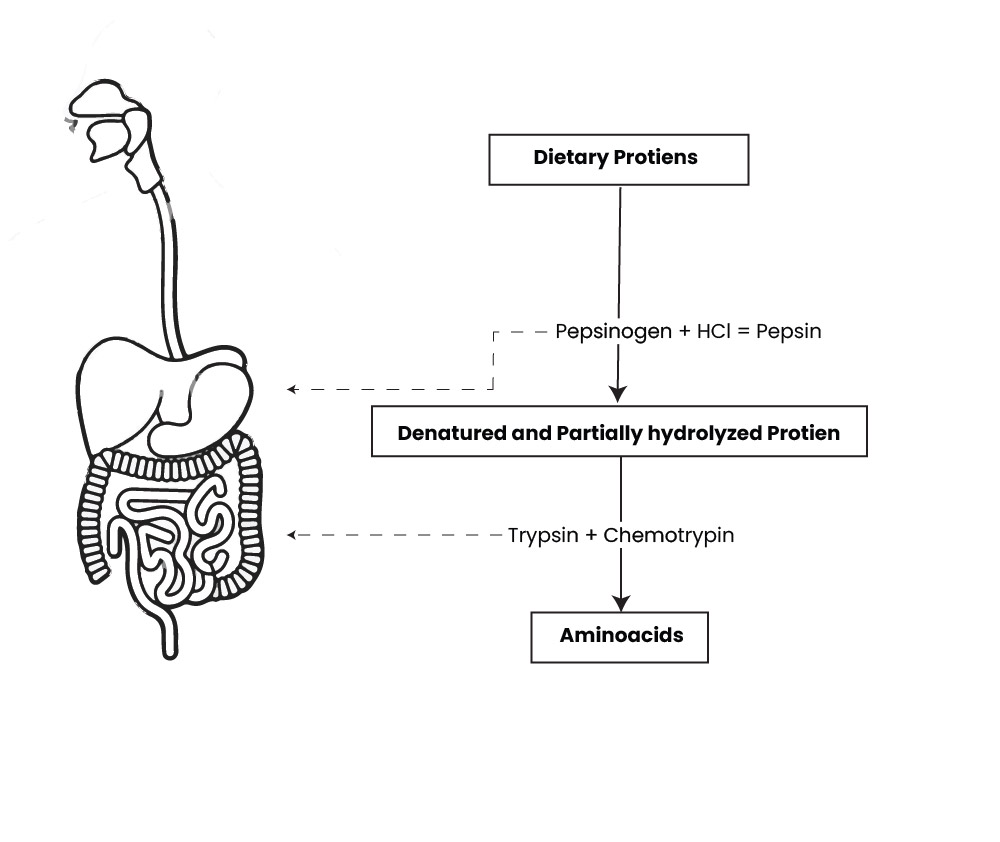
- Digestion of Lipids
Lipids are organic compounds constituting fatty acids that are insoluble in water, making their digestion a complicated process. Thus, unlike carbohydrates and proteins, whose digestion takes place through hydrolysis, the digestion of fats takes place through a process called lipolysis. The process of lipid digestion starts at the stomach where the hydrophobic fat molecules stick together as a large glob of insoluble mass. Large molecules are broken down with the help of bile juice that contains bile salts. Then, the broken molecules are acted upon by pancreatic lipase, the major fat-absorbing enzymes in the body, which further breaks down fats into monoglycerides- the subunit of fatty acids, which are small enough for the small intestine to push through into the bloodstream.

(C) How does Navstar GPS system work for different applications?
Question Breakdown
In this question, the examiner has asked you to briefly describe the working of the Navstar Global Positioning System (GPS) in different applications. So, start your answer with its definition in your own words. When done, move towards the actual part, which is about the working of GPS in general since GPS works almost on the same principle in all applications. Explain it’s working alongside the segments which are responsible for its working. Lastly, Write down the name of a few applications of Navstar GPS from daily life to the macro level. You do not need to draw any diagram in this question.
Answer:
Definition of Navstar GPS
The Navstar Global Positioning System (GPS) is a constellation of 24 satellites in 6 orbits that circle Earth every 12 hours that provides positioning, navigation signals, and timing and synchronization to its users free of cost worldwide. The system is space-based radio-navigation system developed, launched, and maintained by the United States Air Force.
Working Navstar GPS system works for different applications
The Navstar GPS system consists of three major segments
- Space segment
The space segment is made up of the Navstar constellation in orbit around Earth.
- Control segment
The control segment consists of one Master Control Station at a U.S. Air Force base and four additional uncrewed monitoring stations positioned around the world—two in the Pacific Ocean, one in the Indian Ocean, and one in the Atlantic Ocean.
- User segment:
The user segment consists of the millions of GPS receivers picking up and decoding the satellite signals. Hundreds of different types of GPS receivers are designed for installation in agriculture equipment, robotics, automobiles, ships, aircraft, and orbiting satellites, whereas smaller models have been developed for personal navigation.
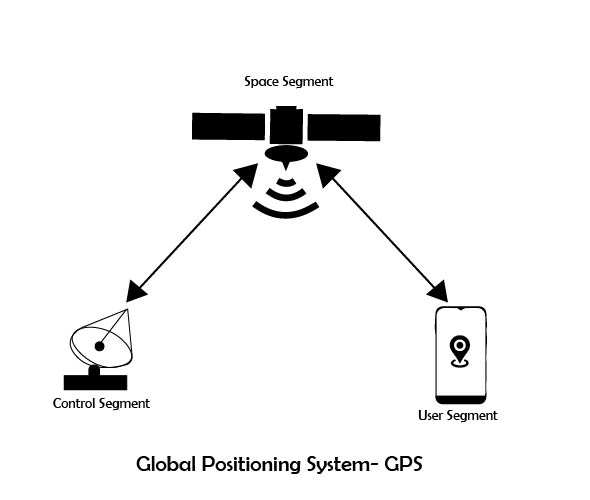
Applications of Navstar GPS
- Telecommunications networks (synchronization of cellular base stations)
- Financial systems (transaction timestamps, high-frequency trading)
- Scientific research (synchronization of data acquisition systems)
- Time-based distance measurement
- Personal navigation devices (e.g., car GPS systems, handheld GPS devices)
- Marine navigation systems (e.g., ship navigation, chart plotting)
- Radio astronomy (very-long-baseline interferometry)
- Earthquake monitoring (measuring ground movement)
(D)
1) Differentiate between network and internet.
2) What is the difference among application, program, and software
Question Breakdown
The question is split into two parts. The first part simply demands the difference between the internet and the network. Thus, to answer it, draw a table explaining the difference, at least five, between the two. Similarly, in the second part, the examiner has asked to explain the difference between three main terms: Application, Program, and software. Thus, draw a table of differences as done in the first part of the question. If you face difficulty in drawing a neat table with four or three rows, write the characters separately under the individual headings. Remember, your creativity is what can help you obtain maximum marks in GSA paper than limitless data.
Answer
1-)
Network vs Internet
| Characteristics | Internet | Network |
| Definition | Internet is a relationship of a few computers linking them from all over the world. | Network is a set of computing devices installed in a location and are generally physically connected |
| Ambit | Internet is global in scope, connecting devices and networks worldwide. | Local in scope, connecting devices within a specific area or organization. |
| Connectivity | Provides connectivity between multiple networks, allowing devices to communicate across different networks. | Enables devices within the same network to communicate and share resources. |
| Accessibility | Publicly accessible, allowing anyone with an internet connection to access online services and information. | Access to a network is limited to authorized users within the network’s boundaries. |
| Protocol | Relies on the Internet Protocol (IP) for addressing and routing data packets across networks. | Uses various protocols such as Ethernet, Wi-Fi, and TCP/IP to facilitate communication within a network. |
| Infrastructure | Complex infrastructure with numerous hardware devices | Network infrastructure requires fewer hardware devices within a specific area. |
| Goal | Facilitates global communication, information sharing, and access to online services, applications, and resources. | Primarily focuses on enabling communication and resource sharing within a specific group or organization. |
2-)
Application vs program vs software
| Difference | Application | Program | Software |
| Purpose | Designed to perform specific tasks or provide specific functionality to end-users. | Written to execute a set of instructions and accomplish a specific computing task. | A broader term encompassing the programs and other operating information used by a computer |
| User Interface | Typically includes a user-friendly interface to facilitate user interactions and tasks. | It may or may not have a graphical user interface (GUI) as its primary means of interaction. | It can include applications with GUI, command-line programs, and other non-user-facing elements. |
| Usage | Intended for end-users to perform specific activities or accomplish particular goals. | Utilized by developers or end-users to carry out specific computing tasks or operations. | Encompasses all types of software used for various purposes, including applications and OS. |
| Examples | – Word processors – Web browsers – Social media apps – Photo editing software – Games | – Text editors – Compilers -Video players – Database – Management systems – Encryption algorithms | – Operating Systems – Antivirus software – Programming languages – Utilities – Data storage systems |

SECTION-II
Question no. 6
(A) A telephone company charges initially Rs. 0.50 and then Rs. 0.11 for every minute. Write an expression that gives the cost of a call that lasts N minutes.
Answer:
Given Data:
Initial Cost = Rs. 0.50 (Fixed)
Per Minute Cost = Rs. 0.11 (Varied)
To find:
An expression for N minutes = ?
Solution:
In order to find an expression which gives N minutes call
Let the expression is equal to X
X= ?
Initially, the price for every call = Rs. 0.50
╦ Rs. 0.50 is a constant and does not change in any circumstance
2nd Condition
Rs. 0.11 for each minute
So, the Equation becomes for N minutes
X = 0.50 + 0.11 N
So the cost of call for N minute = 0.50 + 0.11N where 0.50 is constant and 0.11N for N minutes
(B) Find the missing number in the series below
a) 1, 8, 4, 27, 9, ?
b) 3, 6, 8, 16, 18, ?
c) 2, 8, 512, ?
d) 81, 9, 64, 8, ? , 12
e) 6, 11, 21, 36, 56, ?
Solution:
- 1, 8, 4, 27, 9, ?
First No. = 1
Second number = 2 = (2)3
Third number = 4 = (2)2
Fourth number = 27 = (3)3
Fifth number = 9 = (3)2
Sixth number = 64 = (4)3

So, the next number is 64 as there is 1 incement after alternate numbers
- 3, 6, 8, 16, 18, ?
Looking at the sequence
First number = 3
Second number = 6 = 3 x 2
Third number = 8 = 4 x 2
Fourth Number = 16 = 8 x 2
Fifth number = 18 = 9 x 2
So,
Sixth number = 36 = 18 x 2

- 2, 8, 512, ?
First number = 2
Second number = 8 = (2)3
Third number = 512 = (8)3
So,
Fourth Number = 134,217,728 = (8)3
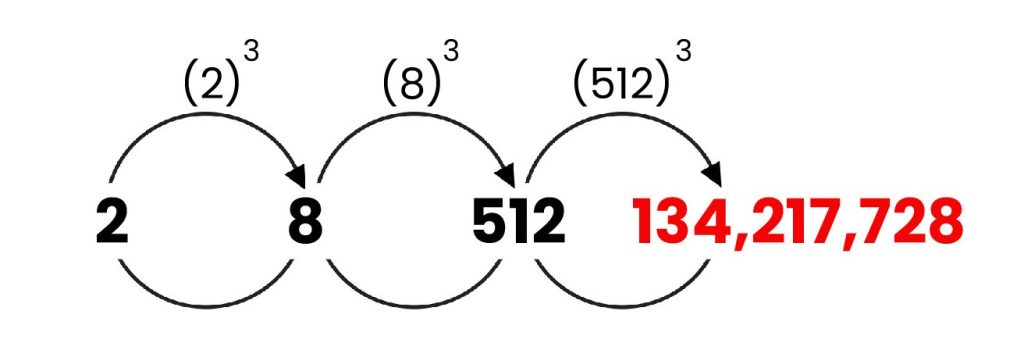
- 81, 9, 64, 8, ? , 12
First number = 81
Second number = 9 = √81
Third number = 64
Fourth Number = 8 = √64
Thus,
Fifth number = 144
When
Sixth number = 12 = √144

- 6, 11, 21, 36, 56, ?
First number = 6
Second number = 11 = 6 + 5
Third number = 21 = 11 + 10
Fourth Number = 36 = 21 + 15
Fifth number = 56 = 36 + 20
So,
Sixth number = 81 = 56 + 25

(C) The perimeter of the rectangle given below is 114 cm. Find the area of the rectangle.
Answer:
Given Data:
Perimeter = 114 cm
Area = ?
Solution:
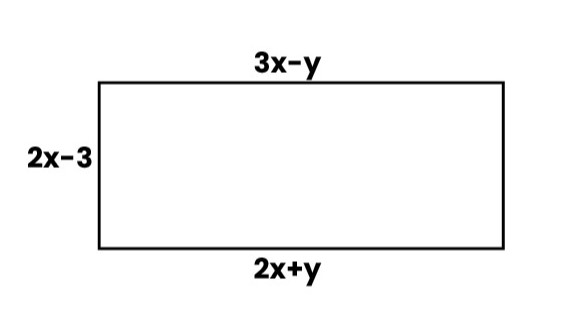
As we know, opposite sides of a triangle are equal
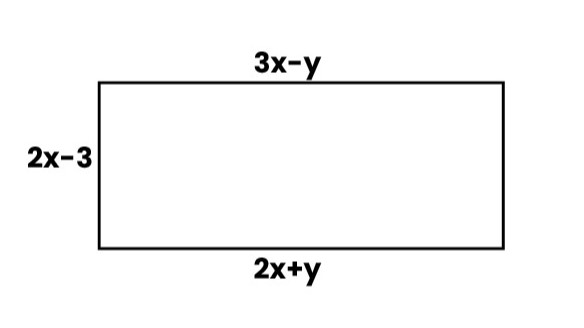
Equating Parallel sides
3x-y = 2x + y
X = 2y ——-> (i)
According to the formula
Perimeter = Sum of all sides
114 = (3x-y) + (2x+y) + (2x-3) + (2x-3)
114 = 9x – 6
Putting the value of “x” from (i)
114 = 9(2y)-6
114 = 18y-6
120 = 18y
y = 120/18
y = 6.667
Now putting the value of “y” in (i)
X = 2(6.667)
X = 13.334 cm
Now, putting the value of “x” and “y” in the figure
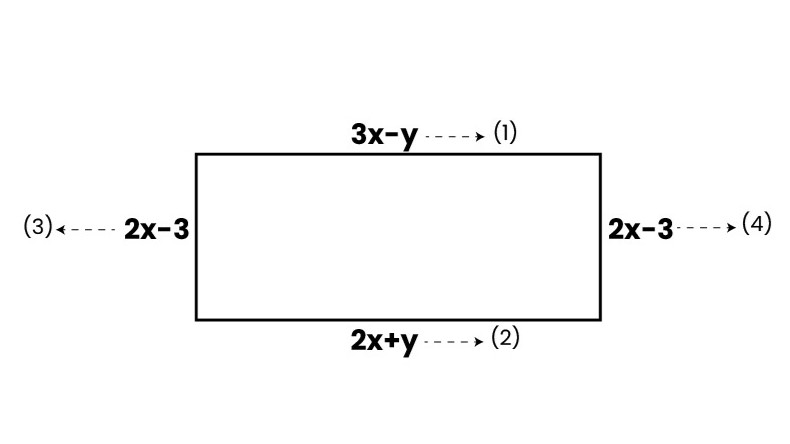
- Putting in (1)
3x-y = 3 (13.334) – 6.667
=33.335 cm
- Putting in (2)
2x+y = 2 (13.334) + 6.667
= 33.335 cm
- Putting in (3)
2x-3 = 2(13.334) – 6.667
= 20.001 cm
- Putting in (4)
2x-3 = 2(13.334) – 6.667
= 20.001 cm
Thus,
Width = 33.335 cm
Length = 20.001 cm
So,
Area = Length x Width
Area = 20.001 x 33.335
= 666.73 cm2
(D) Ahmed stands at point D, 2m in front of a spotlight at point A. He is 1.6m tall and is facing the wall of a building which is 10.5m away from him. How tall (BC) is his shadow on the wall of the building.
Answer:
Ahmed Stands at Point D
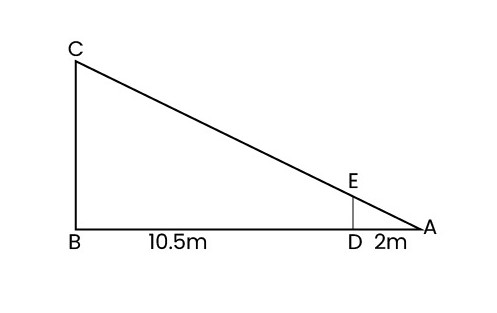
To Find:
BC= ?
Solution:
According to the given condition, Ahmed is standing at D with a height of 1.6m
Shadow on wall = BC
According to the Triangular Theorem, two triangles, ABC and ADE, are similar triangles.
So, their corresponding sides have an equal ratio
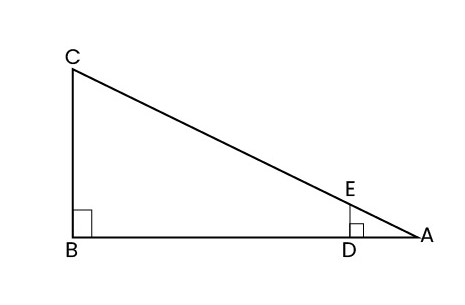
AD/AB = DE/BC ——> (i)
By putting the values
AD = 2m
AB = 2+10.5 = 12.5m
DE = 1.6m
BC = ?
Putting the values in (i)
2/12.5 = 1.6/BC
Solving
BC = 1.6 x 12.5/2
BC = 10m
Hence, the shadow on the wall is 10m
Question No. 7
(A) Ali is standing 10m away from a tree. The distance of his eyes from his feet is 1.5 meters. Given that the distance from his eyes to the top of the tree is 15 metres. Find the height of the tree.
Solution:
To find:
Height of the tree = ?
Solution:
According to the given condition,
- Condition 1
Ali is 10m away from the tree

- Condition 2
Distance from eye to feet = 1.5m
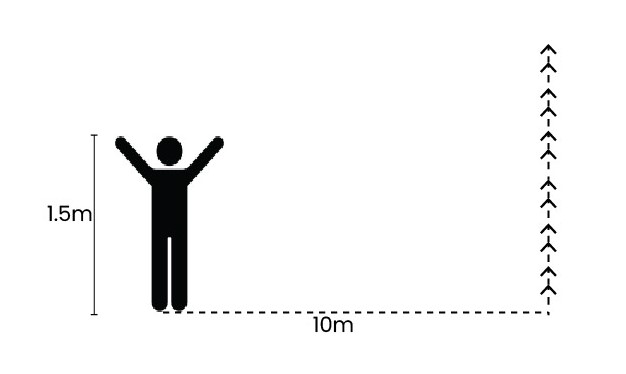
- Condition 3
Eyes from the top of tree distance = 15m
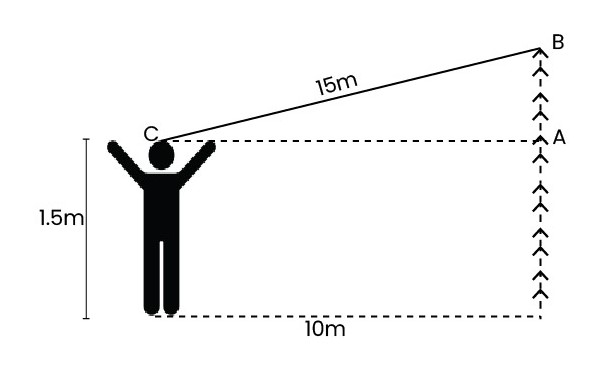
Height of Tree = ?
Triangle ABC =
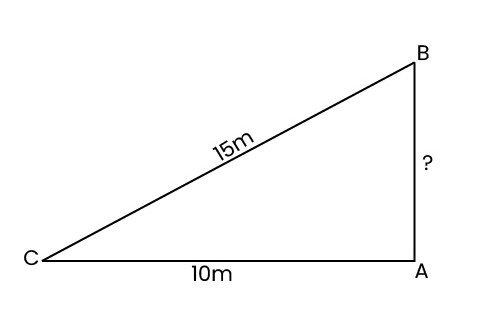
Using Pythagorean Theorem

As we know,
Height of tree = Height of Ali from eye to feet + Altitude
= 1.5 + 11.18
= 12.68m
(B) Find out the correct word from the jumbled spelling given below.
LNUGEF, CKANS, CIREFE, EERAANMOGTP, MNIKPPU
Solution:
- LNUGEF = ENGULF
- CKANS = SNACKS
- CIREFE= FIERCE
- EERAANMOGTP = POMEGRANATE
- MNIKPPU = PUMPKIN
(C) Draw and write the total number of lines of symmetry in a regular hexagon and octagon. How many lines of symmetry are there in a circle?
Solution:
Definition of Line of Symmetry:
The line that divides an object into equal parts- i.e., passes through the center of the object.
Number of Lines of Symmetry in a Regular Hexagon:
A regular hexagon has six equal sides. Therefore, it has six lines of symmetry.
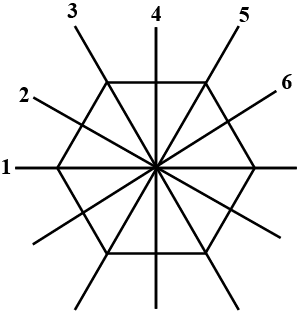
Number of Lines of Symmetry in a Regular Octagon:
A regular hexagon has eight equal sides. Therefore, it has eight lines of symmetry.
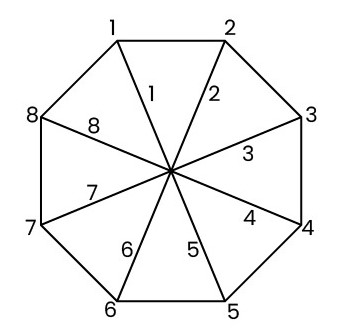
Number of Lines of Symmetry in a Circle:
Since there are an infinite number of lines through the centre, the circle has an infinite number of lines of symmetry.
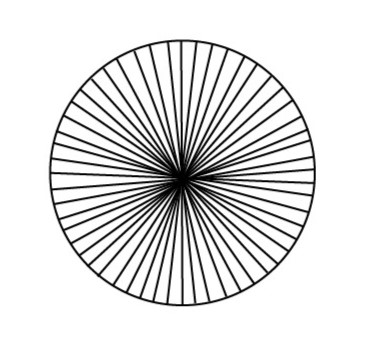
(D) The height of Egyptian pyramid is146.6 meters and a base length is 230.6 meters. Find the volume of that pyramid.
Answer:
Given Data:
Height of Pyramid = 146.6m
Base of Pyramid = 230.6m
To Find:
The volume of the Pyramid = ?
Solution:
Volume of the pyramid= 1/3 (A)(h)
Therefore,
Area of Triangular Pyramid = ½ (b) (h)
As base and height are given
So,
Area of the Pyramid = ½ (146.6) (230.6)
= 16902.9 m2
Now for the Volume
The volume of the Pyramid = 1/3 (A) (h)
= 1/3 (16902.9)(230.6)
= 1299275.72 m3
Question No. 8
A. Ali buys an oven for Rs. 36800 and sells it at a gain of 8.5%. For how much does he sell it?
Answer:
Given Data:
Original Price of the oven = 36800 Rs
Profit Percentage = 8.5 %
To Find:
Selling Price = ?
Solution:
According to the formula

By putting the value

Hence, the selling price of oven is Rs. 39928.
(B) A card is drawn at random from a box containing 12 cards numbered 1, 2, 3, 4, 5, …., 12. Find the probability of drawing (i) “8” , (ii) an even number, (iii) a perfect square, (iv) a negative number, and (v) a number less than 13.
Answer:
Sample Space = {1, 2, 3, 4, 5, 6, ……., 12}
Solution:

- “8”
N (A) = Number of times 8 can be drawn = 1
N (S) = 12
P (A) = 1/12
- An even number
Even Number = N (B) = {2, 4, 6, 8, 10, 12}
N (B) = 6
P (B) = N (B)/ N (S)
= 6/12
= 1/2
- Perfect Square
The product when an integer multiply by itself is a perfect square
For example, 2×2 = 4
3×3 = 9
C= {4, 9}
N (C) = 2
P (C) = N (C)/N(S)
= 2/12
= 1/6
- Negative Integer
D = There is no negative integer in the following sample space
N (D) = 0
P (D) = N (D)/ N (S)
= 0/12
= 0
- Number Less than 13
E = All numbers are less than 13
N (E) = 12
P (E) = N (E)/ N (S)
= 12/12
= 1
(C) The scintillation nuclear radiation detector detects the alpha rays per second. When the energy of the alpha rays (Ea) in MeV increases, the number of counts (Nc) on the detector also increases linearly as shown in the table below
| Ea (Mev) | 0.25 | 0.45 | 0.65 | 1 | 1.4 |
| Nc | 17500 | 23500 | 29500 | 40000 | 52000 |
Draw the graph of Nc as a function of Ea (MeV) and find the energy of the unknown alpha ray if the number of counts are 31600.
Answer:
X- axis = 1 box or 1cm on scale = 0.25 MeV
Y- axis = 1 box or 1cm on scale = 10,000
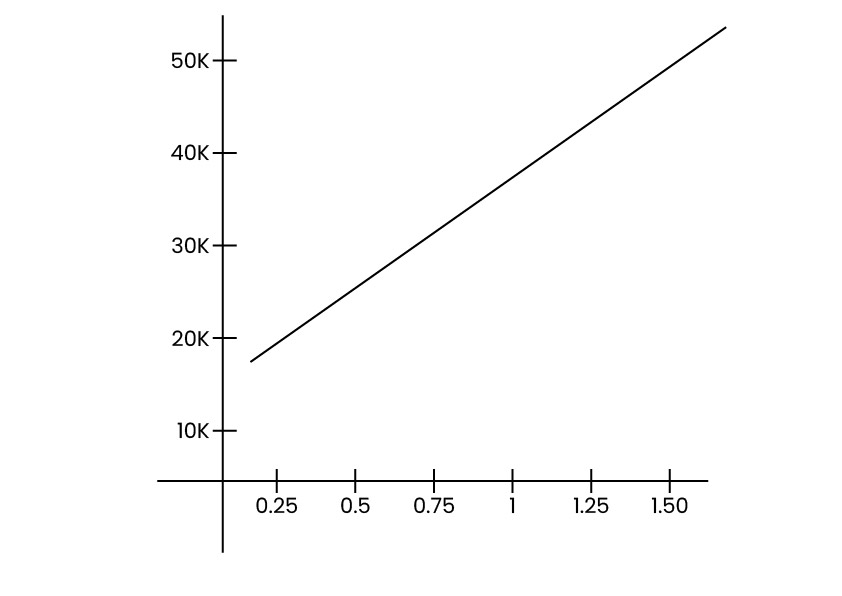
To find the value of energy at 31600, use the method of interpolation
Formula:

Y2 = The next value of Ne
Y1 = The Previous value of Ne
X2 = The next value of Ea
X1 = The previous value of Ea
Y = Given (Ne)
X= To Find
Putting the Values
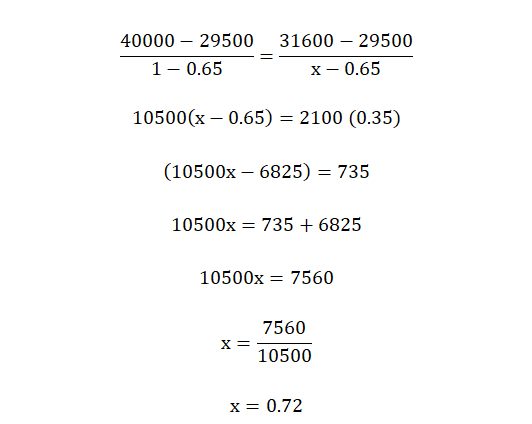
The Value of Ea at 31600 count = 0.72
(D) The y is directly proportional to x2 and y = m for a particular value of x. Find an expression for y in terms of m, when the value of x is doubled.
Answer:
According to the given condition

K = Constant
According to the second condition

Now Writing Equation 1

Now Third condition

So,

Putting the value of K from (ii)

CSS Solved Past Papers’ Essays
Looking for the last ten years of CSS and PMS Solved Essays and want to know how Sir Kazim’s students write and score the highest marks in the essays’ papers? Then, click on the CSS Solved Essays to start reading them.
CSS Solved Essays

CSS Solved General Science & Ability Past Papers
Articles Might Interest You!
The following are some of the most important articles for CSS and PMS aspirants. Click on any to start reading.












